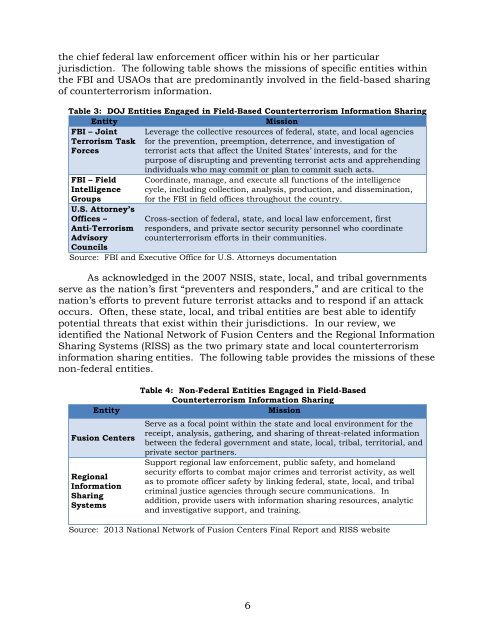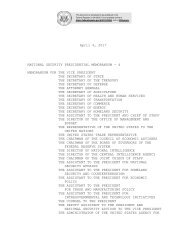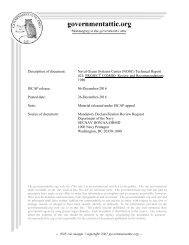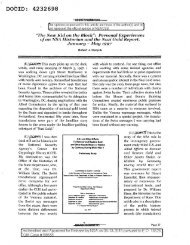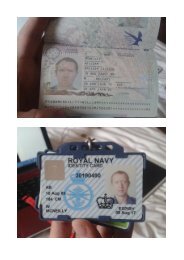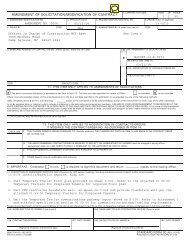Review of Domestic Sharing of Counterterrorism Information
Domestic_Sharing_Counterterrorism_Information_Report
Domestic_Sharing_Counterterrorism_Information_Report
Create successful ePaper yourself
Turn your PDF publications into a flip-book with our unique Google optimized e-Paper software.
the chief federal law enforcement <strong>of</strong>ficer within his or her particular<br />
jurisdiction. The following table shows the missions <strong>of</strong> specific entities within<br />
the FBI and USAOs that are predominantly involved in the field-based sharing<br />
<strong>of</strong> counterterrorism information.<br />
Table 3: DOJ Entities Engaged in Field-Based <strong>Counterterrorism</strong> <strong>Information</strong> <strong>Sharing</strong><br />
Entity<br />
Mission<br />
FBI – Joint Leverage the collective resources <strong>of</strong> federal, state, and local agencies<br />
Terrorism Task for the prevention, preemption, deterrence, and investigation <strong>of</strong><br />
Forces<br />
terrorist acts that affect the United States’ interests, and for the<br />
purpose <strong>of</strong> disrupting and preventing terrorist acts and apprehending<br />
individuals who may commit or plan to commit such acts.<br />
FBI – Field<br />
Intelligence<br />
Groups<br />
U.S. Attorney’s<br />
Offices –<br />
Anti-Terrorism<br />
Advisory<br />
Councils<br />
Coordinate, manage, and execute all functions <strong>of</strong> the intelligence<br />
cycle, including collection, analysis, production, and dissemination,<br />
for the FBI in field <strong>of</strong>fices throughout the country.<br />
Cross-section <strong>of</strong> federal, state, and local law enforcement, first<br />
responders, and private sector security personnel who coordinate<br />
counterterrorism efforts in their communities.<br />
Source: FBI and Executive Office for U.S. Attorneys documentation<br />
As acknowledged in the 2007 NSIS, state, local, and tribal governments<br />
serve as the nation’s first “preventers and responders,” and are critical to the<br />
nation’s efforts to prevent future terrorist attacks and to respond if an attack<br />
occurs. Often, these state, local, and tribal entities are best able to identify<br />
potential threats that exist within their jurisdictions. In our review, we<br />
identified the National Network <strong>of</strong> Fusion Centers and the Regional <strong>Information</strong><br />
<strong>Sharing</strong> Systems (RISS) as the two primary state and local counterterrorism<br />
information sharing entities. The following table provides the missions <strong>of</strong> these<br />
non-federal entities.<br />
Entity<br />
Fusion Centers<br />
Regional<br />
<strong>Information</strong><br />
<strong>Sharing</strong><br />
Systems<br />
Table 4: Non-Federal Entities Engaged in Field-Based<br />
<strong>Counterterrorism</strong> <strong>Information</strong> <strong>Sharing</strong><br />
Mission<br />
Serve as a focal point within the state and local environment for the<br />
receipt, analysis, gathering, and sharing <strong>of</strong> threat-related information<br />
between the federal government and state, local, tribal, territorial, and<br />
private sector partners.<br />
Support regional law enforcement, public safety, and homeland<br />
security efforts to combat major crimes and terrorist activity, as well<br />
as to promote <strong>of</strong>ficer safety by linking federal, state, local, and tribal<br />
criminal justice agencies through secure communications. In<br />
addition, provide users with information sharing resources, analytic<br />
and investigative support, and training.<br />
Source: 2013 National Network <strong>of</strong> Fusion Centers Final Report and RISS website<br />
6


